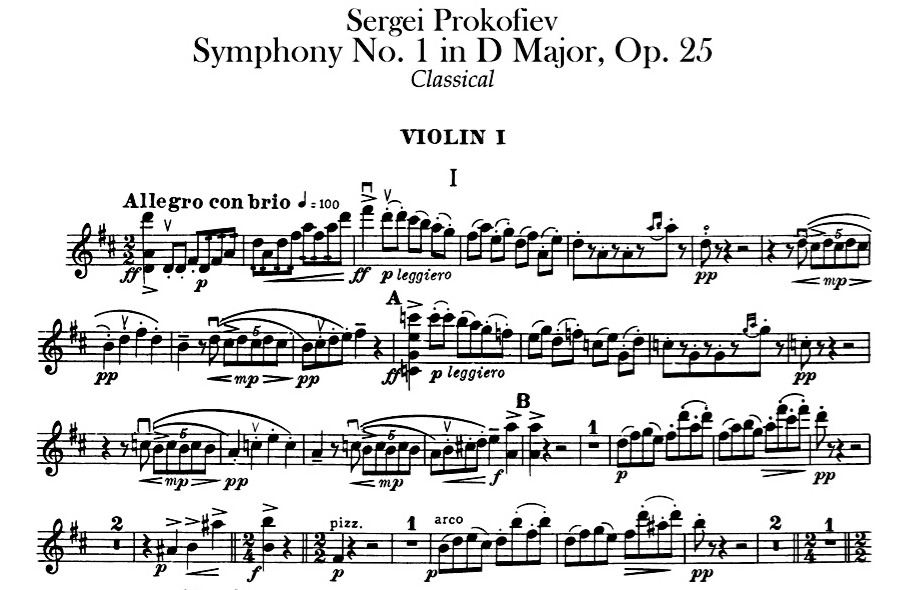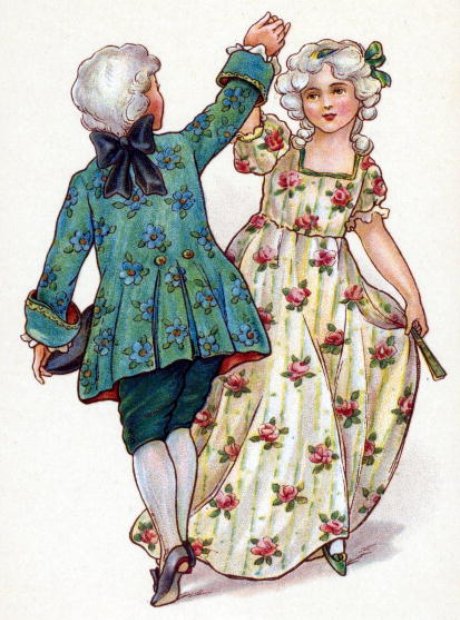"The effect of music is so very much more powerful and penetrating
than is that of the other arts, for these others speak only of the
shadow, but music of the essence."
than is that of the other arts, for these others speak only of the
shadow, but music of the essence."
AUTHOR: Arthur Schopenhauer,
The World as Will and Representation
"The vibrations of music effect the inner recessesThe World as Will and Representation
of our souls more so than in any other art form."
COMPOSER
PROKOFIEV
SYMPHONY NO. 1 IN D MAJOR
'CLASSICAL' OP. 25
Claudio Abbado, Conductor
London Symphony Orchestra
'CLASSICAL' OP. 25
Claudio Abbado, Conductor
London Symphony Orchestra
SYMPHONY NO. 1 IN D MAJOR
'CLASSICAL' OP. 25
'CLASSICAL' OP. 25
(With Music Notation)
I. Allegro 00:00
II. Larghetto 04:25
III. Gavotta 08:33
IV. Finale: Molto Vivace 10:02
'CLASSICAL' OP. 25
I. Allegro
'CLASSICAL' OP. 25
II. Larghetto
 |
| 3rd Movement 1st Theme |
 |
| http://www.annapolishighschool.org/ourpages/auto/2014/4/10/58687560/movement_3.pdf |
SYMPHONY NO. 1 IN D MAJOR
'CLASSICAL' OP. 25
IV. Finale: Molto vivace
 |
| 4th Movement 2nd Theme |
.jpg)
This symphony is scored for a classical
period orchestra consisting of
2 flutes, 2 oboes, 2 clarinets, 2 bassoons,
2 horns, 2 trumpets, timpani and strings
.bmp)
INFORMATION FROM:
Madison Symphony Orchestra Program Notes
Madison Symphony Orchestra Program Notes
http://facstaff.uww.edu/allsenj/MSO/NOTES/1213/1.Sep12.html
By Michael Allsen
Sergey Prokofiev (1891-1953)
CLASSICAL SYMPHONY, OP.25
(SYMPHONY NO.1)
Prokofiev composed this work in 1916-17,
completing the score on September 10, 1917.
He conducted the premiere in St. Petersburg
(Petrograd), on April 21, 1918.
Duration 15:00.
.jpg)
During his student days at the
St. Petersburg Conservatory
and as a young composer/pianist,
Prokofiev was considered to be something
of a radical and an enfant terrible. Frightfully
talented and more than a bit arrogant, the
young Prokofiev battled with his teachers
and the press, who labeled his music
"ultra-modern" and "unintelligible." Despite
his radical musical ideas, however, he held
a deep reverence for the formal clarity of
18th-century music, particularly the
symphonies of Haydn,

and his first symphony shows is a unique
blend of Classical-period forms with
his own style.
Prokofiev brought the Classical Symphony
with him when he left Russia in 1918 and
it was enthusiastically received everywhere
he went; it has remained his single
By Michael Allsen
Sergey Prokofiev (1891-1953)
CLASSICAL SYMPHONY, OP.25
(SYMPHONY NO.1)
Prokofiev composed this work in 1916-17,
completing the score on September 10, 1917.
He conducted the premiere in St. Petersburg
(Petrograd), on April 21, 1918.
Duration 15:00.
During his student days at the
St. Petersburg Conservatory
and as a young composer/pianist,
Prokofiev was considered to be something
of a radical and an enfant terrible. Frightfully
talented and more than a bit arrogant, the
young Prokofiev battled with his teachers
and the press, who labeled his music
"ultra-modern" and "unintelligible." Despite
his radical musical ideas, however, he held
a deep reverence for the formal clarity of
18th-century music, particularly the
symphonies of Haydn,

and his first symphony shows is a unique
blend of Classical-period forms with
his own style.
 |
| http://www.violinexcerpts.com/prokofiev-classical-symphony-mvt-i-page-1/ |
with him when he left Russia in 1918 and
it was enthusiastically received everywhere
he went; it has remained his single
usual style, Prokofiev wrote in his autobiography:
.jpg)
.jpg)
"I spent the summer of 1917 in the country near
St. Petersburg all alone, reading Kant
 |
| Philosopher: Immanuel Kant |
and working a great deal. I deliberately left
my piano behind, as I wished to try
composing without it...
I had been toying with the idea of writing
an entire symphony in this manner; I
believed that the orchestra would thus
sound more natural...
It seemed to me that, had Haydn lived in
our own day, he would have retained his
own style, while accepting something of
the new at the same time. That was the
kind of symphony I wanted to write: a
symphony in the classical style.
When I saw that my idea was beginning
to work, I began to call it the Classical
Symphony; in the first place, because it
was simpler, and secondly for the fun of it...
and in the secret hope that I would prove
to be right if the symphony really did
turn out to be a 'classic.'
I composed the symphony in my head
during walks in the country."
The end result of this mental exercise was a
little jewel of a symphony; four movements in
the space of 15 minutes. Prokofiev uses
Classical forms in each of the movements,
and he also uses a small, Haydnesque
orchestra: pairs of flutes, oboes, clarinets,
bassoons, trumpets, and horns, with
timpani and strings.
The opening movement (Allegro) is a miniature
sonata form, based upon two main ideas. The
first of these is heard immediately in the strings.
The second main theme has the violins playing
large, deliberately awkward leaps (ironically
marked "with elegance!") above a walking bass
line in the bassoons. Although the form follows
Haydn's textbook throughout, there are many
quirky turns of harmony that clearly show
that this is a work of the 20th century,
rather than the 18th.
The slow movement (Larghetto) has a simple
three-part form. The opening section is
dominated by a graceful melody played by the
violins. The central section is more active,
beginning with quick, rising lines in the
woodwinds. At the end, Prokofiev blends
these two contrasting characters together.
In a Haydn symphony, the third movement is
typically a Minuet; a courtly, triple-meter
dance. In the Classical Symphony, Prokofiev
reaches even further back into the 18th
century, and sets his third movement as a
Gavotte (Non troppo allegro). This energetic
Baroque dance
 |
| Gavotte |
Prokofiev makes the most of its rustic grace.
Just as we expect the final cadence of the
gavotte, he launches unexpectedly into the
final movement (Molto vivace). Here,
Prokofiev returns to sonata form, working
through the form in a terse way that makes
the most of a series of light-footed themes.
There is a tiny but intense development of
these ideas at the center, before a short
recapitulation and blazing coda.
.bmp)
CLASSICAL SYMPHONY
CLASSICAL SYMPHONY
ANALYSIS #2
.bmp)
LINKS
http://www.sprkfv.net/journal/three13/classical2.html
http://www.classicfm.com/composers/prokofiev/music/sergei
-prokofiev-symphony-no-1-d/#pK60q14Hjs552e5p.97
http://imslp.org/wiki/Symphony_No.1,_Op.25_%28Prokofiev,_Sergey%29
http://group1music8.weebly.com/
http://mrboneibmusic.blogspot.com/2013
05/prokofiev-classical-symphony.html
http://edgreenmusic.org/Prokofie-a.htm
https://tiboresque.wordpress.com/2013/10/09/prokofiev-
symphony-no-1-in-d-major-op-25-classical-symphony/
http://en.wikipedia.org/wiki/Symphony_No._1_%28Prokofiev%29
http://kennethwoods.net/blog1/2012/04/28/explore-
the-score-prokofiev-classical-symphony/
https://sites.google.com/site/prokofievclassicalsymphony/i-allegro
http://www.sd5.k12.mt.us/cms/lib3/MT01001507/
Centricity/Domain/114/Yellow_River_2.pdf
https://societymusictheory.org/files/2014_handouts/lomax.pdf
http://genedelisa.com/2010/01/prokofiev-classical-symphony/
https://content.thespco.org/music/compositions/symphony-no-1-classical-sergei-prokofiev/
https://classicalmusicquest.wordpress.com/2013/01/13/
prokofievs-symphony-no-1-classical-symphony-op-25/
http://soniclabyrinth.blogspot.com/2010/10/thinking-classical-symphony-memory-in.html
http://www.salemchamberorchestra.org/program-note-prokofiev-symphony-1-classical/
http://genedelisa.com/2010/01/prokofiev-classical-symphony/
http://www.hhso.org/program-notes/prokofiev-haydn/index.htm
http://blogs.yis.ac.jp/14kawamurah/2013/10/27/classical-symphony-prokofiev-second-movement/
http://www.annapolishighschool.org/ourpages/auto/2014/4/10/58687560/movement_2.pdf
http://www.annapolishighschool.org/ourpages/auto/2014/4/10/58687560/movement_3.pdf
INTRO. TO INSTRUMENTS
GRANADA1. KEYBOARDS: RECITAL PRACTICE
a. BLUE BOOK SONGS USING 2 HANDS AT THE SAME TIME
1). ODE TO JOY
2). JINGLE BELLS
2. VIOLIN
(small groups of students at a time)
a. Bowing on shoulder
b. Bowing on violin UH of bow
HILLVIEW
1. KEYBOARDS: RECITAL PRACTICE
a. BLUE BOOK SONGS USING 2 HANDS AT THE SAME TIME
1). ODE TO JOY
2). JINGLE BELLS
2. BACH
a. Worksheet Study Cards
GRANADA BEG. STRINGS
1. CIELITO LINDO
2. CHARIOTS OF FIRE
3. HO HEY
4. CIDER HOUSE RULES
2. CHARIOTS OF FIRE
3. HO HEY
4. CIDER HOUSE RULES
HILLVIEW ORCHESTRA
1. MANANITAS I and II
2. 21 GUNS
3. NUMB
1. MANANITAS I and II
2. 21 GUNS
3. NUMB












.jpg)
.jpg)
.jpg)
.jpg)
.jpg)